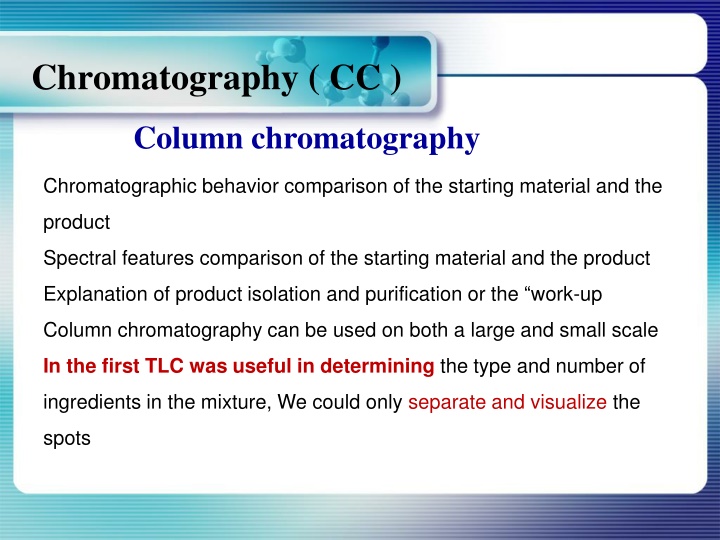
Column Chromatography: Techniques and Applications
Explore the principles and applications of column chromatography, a vital separation technique in chemistry. Understand the chromatographic behavior, spectral features, and product isolation methods. Discover how stationary phases like alumina and silica play a crucial role in separating compounds based on polarity.
Download Presentation

Please find below an Image/Link to download the presentation.
The content on the website is provided AS IS for your information and personal use only. It may not be sold, licensed, or shared on other websites without obtaining consent from the author. If you encounter any issues during the download, it is possible that the publisher has removed the file from their server.
You are allowed to download the files provided on this website for personal or commercial use, subject to the condition that they are used lawfully. All files are the property of their respective owners.
The content on the website is provided AS IS for your information and personal use only. It may not be sold, licensed, or shared on other websites without obtaining consent from the author.
E N D
Presentation Transcript
Chromatography ( CC ) Column chromatography Chromatographic behavior comparison of the starting material and the product Spectral features comparison of the starting material and the product Explanation of product isolation and purification or the work-up Column chromatography can be used on both a large and small scale In the first TLC was useful in determining the type and number of ingredients in the mixture, We could only separate and visualize the spots
Chromatography is a technique in which compounds to be separated are distributed between a mobile phase and a stationary phase. In such a system, different distributions based on selective adsorption give rise to separation. There are different types of chromatography, such as paper, thin layer, or column chromatography, each with its own strengths and weaknesses. . The stationary phase, a solid adsorbent, is usually placed in a vertical glass column and the mobile phase, is added from the top and let flow down through the column by either gravity or external pressure www.themegallery.com
Column Chromatography will be used to separate the starting material from the product but TLC will be used to monitor the effectiveness of this separation 1- glass column 2- mobile phase ( eluent , solvent) 3- stationary phase 4-cotton or glass wool www.themegallery.com
Glass column Glass tube with tap diameter of tube beginning a pencil size to a large size www.themegallery.com
Stationary phase alumina and silica are the two most popular stationary phases in column chromatography The more polar sample will be retained on the stationary phase longer. Thus the least polar compound will elute from the column first, followed by each compound in order of increasing polarity. interactions between the mobile and stationary phase are based on the same principles for CC and TLC Stationary phases for CC can come in a variety of sizes, activities, acidic and basic variations for both alumina and silica The type of adsorbent, the size of the column, the polarity of the mobile phase as well as the rate of elution all affect the separation. These conditions can be manipulated to get the best separation for your mixture. Size of particles of stationary phase www.themegallery.com
Silica Gel may be regarded as a typical polar sorbent. The relative adsorptivity of different molecular groups or substitutes on silica gel is similar to that observed for other polar adsorbents. The silica gel surface is weakly acidic and there is a tendency towards preferential adsorption of strongly basic substances relative to adsorption on neutral or basic adsorbent. It also finds application in reversed phase partition chromatograph Application:- In the separation and purification of steroids, lipids amino acids, dyes, alkaloids, phenolic compounds and pharmaceutical intermediates,Separation and extraction of herbal ,synthetic drugs and bioactive substances. Dehydration and purification of organic material www.themegallery.com
ALUMINA www.themegallery.com
Choosing Solvents Solvent systems for use as mobile phases in CC can be determined from previous TLC experiments, the literature, or experimentally. Normally, a separation will begin by using nonpolar or low polarity solvent, allowing the compounds to adsorb to the stationary phase, then SLOWLY switching the polarity of the solvent to desorb the compounds and allow them to travel with the mobile phase. The polarity of the solvents should be changed gradually. On a macroscale, the mixing of two solvents can create heat and crack the column leading to a poor separation. Some typical solvent combinations are ligroin-dichloromethane, hexane-ethyl acetate and hexane-toluene. Often an experimentally determined ratio of these solvents can sufficiently separate most compounds. Solvents such as methanol and water are normally not used because they can destroy the integrity of the stationary phase by dissolving some of the silica gel www.themegallery.com
Packing the Column There are several acceptable methods when packing a column The slurry method The slurry method normally achieves the best packing results , The slurry method is often used for macroscale separations. Dry packing is the method of choice for a microscale column. Begin by filling the column with a nonpolar solvent. Slowly add the powdered alumina or silica while gently tapping the side of the column with a pencil. The solid should float to the bottom of the column. Try to pack the column as evenly as possible; cracks, air bubbles, and channels will lead to a poor separation www.themegallery.com
Flash chromatography Column chromatography is often very time consuming. Allowing the solvent to elute through the column one drop at a time takes patience. One method to speed up the process is to use Flash Chromatography. This method uses a pressure of about 10 psi of air or nitrogen to force the mobile phase through the column. Because the rate of the mobile phase is increased, in general, this method gives a poorer separation. However, by using a finer grade of alumina or silica, flash chromatography can be used to increase the speed without lowering the quality of the separation www.themegallery.com
